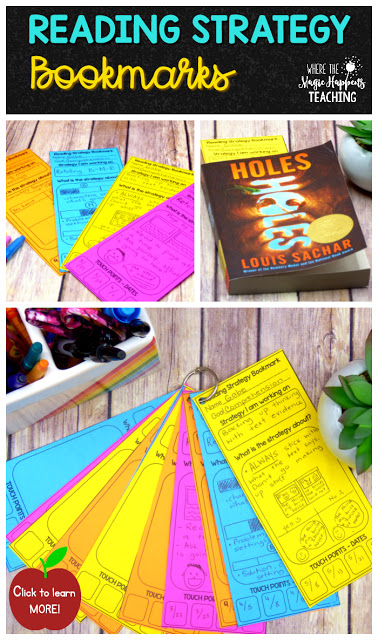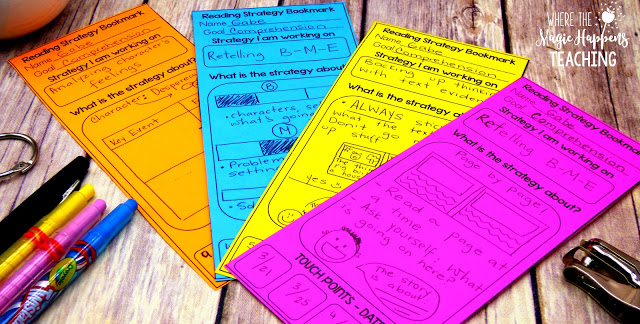Not long ago a good friend of mine from grad school contacted me to ask about great “teaching” books for her to read during her summer. {That just goes to show how teachers use their summers!} In particular, she wanted to know about how to approach her small groups during her literacy block in order to better meet the needs of her readers and be able to move them forward.
Types of Small Groups
There are three main types of small groups that I have experience with:
Guided reading, strategy groups, and close reading.
You might be wondering, what type of approach to use with your small groups. Actually, your decision should be based on your data and your knowledge of your students as readers.
I repeat: You have to know your data and your students.
Depending on where you teach, your school or district may use a myriad of assessment tools that will help you get to know your students from the beginning of the year. Or… you may be provided with no assessment tools at all. There are definitely benefits and problems on both ends of this spectrum.
Guided Reading
Guided reading is an instructional approach that involves a teacher working with a small group of students who have similar reading behaviors and similar reading levels. All the students read the same text, and the teacher provides group and individual support targeting different reading strategies and skills. The text might be slightly above the students’ reading level. BEWARE!! Guided reading is NOT round robin reading.
A guided reading lesson starts the moment you choose “the book.” However, you always need to keep in mind that you are not teaching the book, you are teaching the reader! When I do a guided reading group, I look at the reading behaviors that I need to notice and support. Those reading behaviors revolve around my state standards.
Within a guided reading lesson, I am also able to target a ton of science and social studies content area concepts.
One last thing: keep groups flexible. This is a must.
I use these two books for guided reading lesson planning
 |
| Click on pic to get from Amazon! |
 |
| Click on Pic to get from Amazon! |
Close Reading Groups
I have written about close reading HERE. According to Fisher & Frey “Close reading is an instructional routine in which students are guided in their understanding of complex text.” I love their book and everything and anything that you want to know about the phases of close reading, close reading routines, and text dependent questions you can find there:
 |
| Click on pic to get from Amazon! |
These are some instructional implications of close reading for students in the primary grades:
- Text selection: text complexity is significantly higher than student’s instructional reading level. This means that your students may no be able to problem solve or fully understand the text during the first cold read!
- Initial Reading: the teacher reads the text aloud to students, although they are not grasping its deeper meaning. And they are not meant to.
- Annotation: the teacher guides annotation practices using displayed text and fosters collaboration to develop annotations. If the teacher is the only one doing the talking, then you are the one doing the close reading, not the students. #somethingtothinkabout
- Repeated Readings: the teacher reads aloud multiple times, students read along. Some students may read text independently in subsequent readings.
- Text-Based Discussions: students engage in extended conversation. They move from literal, to structural, to inferential!
- Responding to Text: students write collaboratively and independently with teacher support and guidance.
One last thing: close reading can be done as a whole group too! My friend Marie from The Literacy Spot, for example, does close reading routines with leveled books. If your students need to deepen comprehension skills, then you should give close reading a try!I have also developed 16 science close reading brochures: birds, amphibians, reptiles, mammals, arctic animals, forces and motion, sound, weather, rocks and minerals, ocean animals, the solar system, land forms, and more!
Strategy Groups
A strategy group is a small focused group that targets a literacy strategy, it could be print work, vocabulary, fluency, comprehension, or reading habits. My strategy lessons are normally fast paced, VERY intentional, and focus on the “how-to” of reading.
Unlike a guided reading group, when students meet with the teacher, they may bring a book of their choice with which they can observe, try, try some more, practice, and work towards meeting a goal. The students in the group have different reading levels, but they all seek to accomplish a common reading strategy that is not yet automatic. I might meet with my strategy groups right after a mini-lesson or during intervention time.
However, I also teach my students reading and writing strategies during one-to-one conferences. I think of it as of quality over quantity.
The strategies/goals that we set together, are the result of careful data analysis and observations during guided reading.
As I am a visual learner myself, I have always thought that the best way to guide a reader through a strategy is to provide them with a visual of what the strategy looks like. I have been providing my readers with these visuals:
I use these bookmarks when I confer one-on-one with my readers. I model, draw, and communicate the strategy right there, on the spot. No need for pre-made stuff! If you are truly modeling a reading strategy, this is how you do it, with the student. Period.
The students get to keep their bookmark and I use it with the books inside their book boxes. I also provide them with sticky notes that they use in their book to mark the spot where they used the strategy.
When a goal has been met, they put their reading strategy bookmarks on a ring. They keep them together for future reference!
This is a one page PDF file that will be sent right to your inbox! Make sure to use your personal email, as school emails will probably send me to your spam folder. LOL!!?
If you are thinking about conducting strategy groups with your readers, this is the BIBLE when it comes to knowing what and how to teach reading strategies:
 |
| Click on the pic the get from Amazon! |
The Bottom Line
You may be wondering what type of small group works best, or how you go about choosing the type of small group approach that will benefit your students the most. This is what I have to tell you from the heart:
- Every teacher should use any and all of the three small group approaches. In order to meet the needs of your students, you need to know and implement various instructional models. I have one-on-one conferences, strategy groups, guided reading groups, and close reading groups going everyday!
- Learning about this takes time, energy, and money. If you are a new teacher, or a veteran teacher trying to better yourself in the area of literacy, choose one type of small group approach a year, learn from quality research (books, articles, etc), and from your own experience. My literacy block looks the way it does because I have been teaching for 16 years, and I have done my homework. So focus on one thing at a time, you will get there!
- Learn from other teacher friends. Ask around, observe, and choose quality teacher friends. Don’t be afraid to acknowledge that you don’t know it all. Heck?! NO ONE DOES!!!The best teachers are not the ones who know it all, but the ones who are willing to learn and be better year after year. Don’t you think?
 |
| PIN ME!! |
Thanks for reading teacher friends, I hope you have learned something useful that you can apply in your classroom! I will be blogging some more next weekend!!
Until next time!






[…] Small group time is definitely my most favorite time of my teaching day. I know I am reaching ALL my readers and writers when my small groups target the strategies and skills that they need to move forward. My best teaching days happen when I teach my heart out, and when I meet with my small groups without interruption. This year I have 4 different types of small reading groups going: targeted intervention, guided reading, strategy groups, and close reading. I have written about the different type of small reading groups HERE. […]